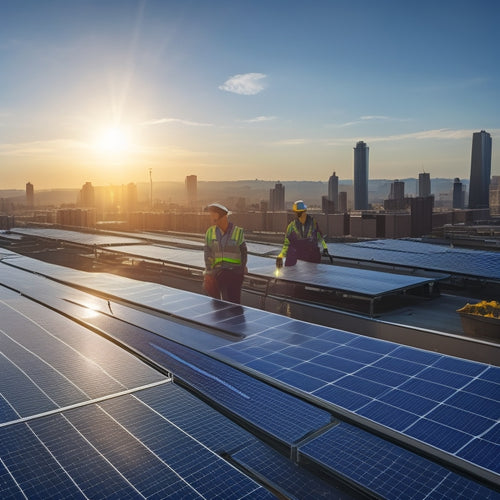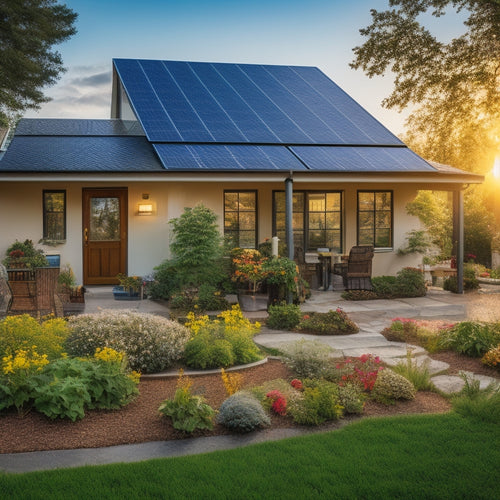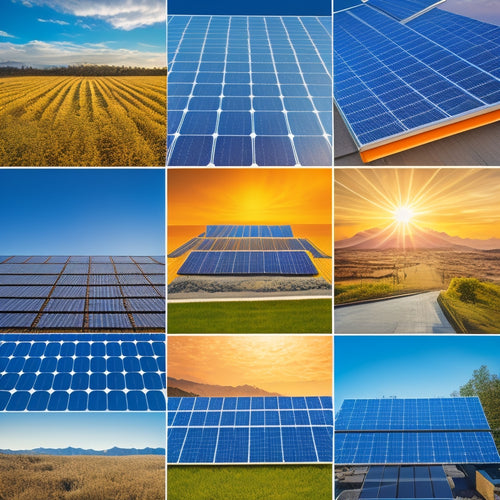
Estimating Commercial Solar Panel Installation Costs
Share
You'll typically pay between $2.50 and $3.50 per watt for a commercial solar panel installation, but understanding the factors that influence this cost is important to making an informed decision. System size, complexity, roof type, and condition all impact the final cost. Energy efficiency upgrades, local incentives, and rebates can also reduce your expenses. Additionally, ongoing maintenance expenses, such as cleaning and replacement costs, should be factored in. By considering these variables, you can estimate commercial solar panel installation costs accurately. Now, it's time to dive deeper into the specifics that will help you make the most cost-effective decision for your business.
Key Takeaways
• Accurate cost estimates require understanding upfront costs, ranging from $2.50 to $3.50 per watt, and considering technology advancements.
• System size and complexity significantly impact installation costs, with larger systems benefiting from economies of scale.
• Roof type and condition influence installation complexity, with older or damaged roofs requiring repairs and affecting structural integrity.
• Energy efficiency upgrades, such as LED lighting and energy-efficient HVAC, can reduce energy load and optimize system performance.
• Local incentives and rebates, including state tax credits and utility company discounts, can significantly offset installation costs and improve ROI.
Understanding Solar Panel Costs
When considering a commercial solar panel installation, understanding the upfront costs is crucial. These costs typically range from $2.50 to $3.50 per watt, depending on the system's size and quality.
Technology advancements have led to decreased costs over the years, making solar energy more competitive with fossil fuels. To create accurate financial projections, having a grasp of industry standards and cost benchmarks is vital.
A thorough market analysis will help you navigate regulatory frameworks and optimize your investment. Understanding the costs associated with commercial solar panel installation will better equip you to make informed decisions about your energy future.
System Size and Complexity
As you explore the factors affecting commercial solar panel installation costs, the system size and complexity emerge as critical factors, with larger systems typically yielding lower costs per watt. When determining the ideal system size, you'll need to take into account your energy demands and the panel capacity required to meet those needs.
Here are key factors to take into account:
-
Larger systems often benefit from economies of scale, reducing the cost per watt
-
Complex systems with multiple inverters or trackers may increase installation costs
-
Higher-capacity panels can reduce the overall system size, but may also increase upfront costs
-
Energy storage systems (ESS) can add complexity and cost to the installation
-
System monitoring and maintenance requirements can impact overall complexity and cost
Roof Type and Condition
When estimating commercial solar panel installation costs, you'll need to take into account the roof type and condition of your building. The age and material of your roof will impact the installation process, as will the structural integrity of the roof itself.
You'll want to evaluate these factors to determine if any additional repairs or reinforcements are needed before installing your solar panel system.
Roof Age and Material
The age and material of your roof greatly influence the complexity and cost of commercial solar panel installation. Older or damaged roofs may require additional repairs or replacement before the installation can proceed. This is because the roof's condition affects the weight and stress that the solar panels will add to your building.
You'll want to take into account the durability of your roof material, as some materials are more prone to damage or degradation over time.
- Asphalt shingles, for example, may need to be replaced every 20-30 years, while metal roofs can last 50 years or more.
Roof replacement can add significant costs to your solar panel installation project. Material durability is essential, as it affects the structural integrity of your roof and the overall success of your solar panel installation.
A thorough assessment of your roof's age and material is vital for estimating the total cost of your project. Be prepared to factor in potential roof repairs or replacement when budgeting for your commercial solar panel installation.
Structural Integrity Checks
You'll need to conduct a structural integrity check to determine if your roof can support the added weight of solar panels, taking into account the roof type and condition. This involves evaluating the roof's construction, including the material, age, and current condition. You'll need to verify that your roof complies with local building codes and can withstand the additional load of the solar panels.
| Roof Type | Load Calculation Considerations |
|---|---|
| Flat roof | Dead load, live load, and wind load calculations |
| Metal roof | Structural integrity of metal framing, snow load calculations |
| Asphalt shingle roof | Age and condition of shingles, roof pitch, and drainage |
Energy Efficiency Upgrades
When you're preparing for a commercial solar panel installation, it's crucial to think about energy efficiency upgrades.
You'll need to conduct an energy audit to identify areas of improvement, which will also help you determine the most suitable system size for your solar panel installation.
Energy Audits Required
Conducting an energy audit is essential to identifying areas in your building that can benefit from energy efficiency upgrades, which in turn can help maximize the performance of your future solar panel installation. By conducting an energy audit, you'll be able to pinpoint areas of energy inefficiency and prioritize upgrades that will have the greatest impact on your energy consumption.
Some key aspects of an energy audit include:
-
Reviewing your past energy bills to identify patterns and trends in energy consumption
-
Conducting on-site inspections to identify areas of energy inefficiency
-
Using specialized equipment to detect air leaks and insulation gaps
-
Analyzing your building's envelope, lighting, and HVAC systems
-
Providing recommendations for energy-saving upgrades and improvements
System Sizing Importance
Optimizing your building's energy efficiency through targeted upgrades is essential before sizing your commercial solar panel system, as it directly impacts the system's performance and overall return on investment. You'll want to focus on reducing energy usage through measures like LED lighting, energy-efficient HVAC systems, and insulation upgrades. This will help you determine the correct system size and minimize waste.
| Energy Efficiency Measure | Impact on System Sizing |
|---|---|
| LED Lighting | Reduces energy load, allowing for smaller system size |
| Energy-Efficient HVAC | Decreases peak energy usage, optimizing system performance |
| Insulation Upgrades | Reduces energy loss, resulting in more accurate load calculations |
Incentives and Rebates
By investing in energy efficiency upgrades, you can capitalize on various incentives and rebates that help offset the costs of your commercial solar panel installation. These incentives can greatly reduce your upfront costs, making your investment more financially viable.
The Federal Tax Credit allows you to claim a percentage of your total installation costs as a credit on your taxes.
State Credits offer additional incentives for businesses investing in renewable energy.
Utility rebates provide financial incentives for businesses that invest in energy-efficient solutions.
Performance-based incentives reward businesses for generating a certain amount of renewable energy.
Local government incentives offer additional financial benefits for businesses investing in sustainable energy solutions.
Local Incentives and Rebates
To greatly reduce the upfront cost of commercial solar panel installation, it's crucial to take advantage of local incentives and rebates, which vary widely depending on your location and the type of project. These incentives can markedly lower your initial investment, making solar energy a more viable option for your business.
For instance, you may be eligible for state tax credits, which can offer a substantial reduction in your tax liability. Additionally, many utility companies offer discounts for commercial customers who install solar panels. Researching and exploring these local incentives and rebates is vital to maximize your savings.
Installation Company Pricing
When evaluating installation companies, your cost per watt will largely depend on the pricing structure and services offered by each provider. Be sure to research and compare prices from different companies to find the best fit for your project.
Here are some key factors to take into account:
-
Company reputation: Look for companies with a proven track record of successful installations and satisfied customers.
-
Industry standards: Verify that the company adheres to industry standards for installation, maintenance, and safety.
-
Equipment quality: Check the quality of the solar panels and other equipment used by the company.
-
Warranty and support: Review the company's warranty and support options in case of system failures or issues.
-
Additional services: Take into consideration companies that offer additional services, such as energy monitoring and maintenance plans.
Ongoing Maintenance Expenses
After the initial installation, regular maintenance is essential to guarantee top performance and extend the lifespan of your commercial solar panel system. This ongoing upkeep comes with associated expenses. You'll need to factor in the costs of regular cleaning, which can range from $1,000 to $3,000 per year, depending on the size of your system.
Performance monitoring is also vital to make sure your system is operating at peak levels. This can be done through remote monitoring systems, which can cost around $500 to $2,000 per year. Additionally, you may need to replace inverters or other components over time, which can cost upwards of $5,000.
Frequently Asked Questions
Can I Install Solar Panels on a Metal or Clay Tile Roof?
You can install solar panels on a metal or clay tile roof, but consider roof durability and select installation methods that won't compromise the roof's integrity, ensuring a secure and efficient setup.
Do Solar Panels Work Efficiently in Shady Areas or on North-Facing Roofs?
'A million tiny shades can't bring you down! You'll be relieved to know that, with Shade Mitigation strategies, solar panels can still produce significant energy on north-facing roofs, but ideal Roof Orientation is key for maximum efficiency.'
How Long Does It Take to Recoup the Cost of a Commercial Solar Panel System?
You'll recoup the cost of a commercial solar panel system in 5-7 years, depending on System Sizing and Financial Projections, which consider factors like energy usage, local incentives, and electricity rates, ensuring a clear return on investment.
Can I Use Solar Panels to Power Electric Vehicle Charging Stations?
You can power electric vehicle charging stations with solar panels, integrating them into your charging infrastructure. This setup allows you to harness renewable energy, reducing your reliance on the grid and lowering your carbon footprint.
Are There Any Tax Implications for Commercial Solar Panel Installations?
You'll benefit from tax credits, such as the Solar Investment Tax Credit, which can cover up to 26% of your commercial solar panel installation costs, and depreciation benefits, allowing you to write off a significant portion of the investment.
Related Posts
-

Solar Installation Guide for Commercial Properties
Implementing solar energy solutions in your commercial property can lead to significant long-term savings and sustain...
-

How to Achieve Energy Independence at Home
To achieve energy independence at home, start by investing in renewable energy sources like solar panels, wind turbin...
-

Comparative Analysis of Top Solar Brands
To conduct a comparative analysis of top solar brands, focus on key metrics like durability, energy efficiency, and s...


